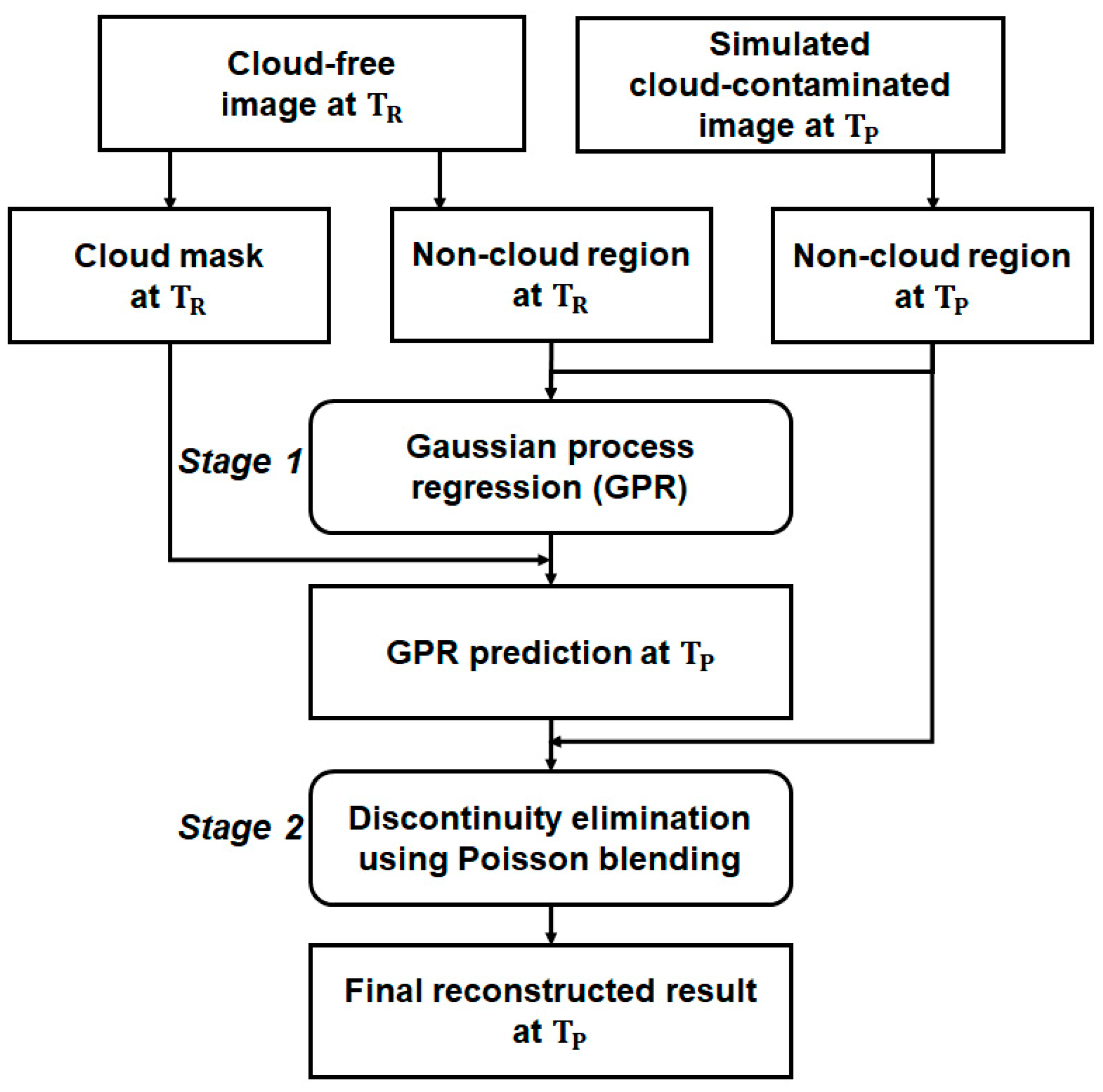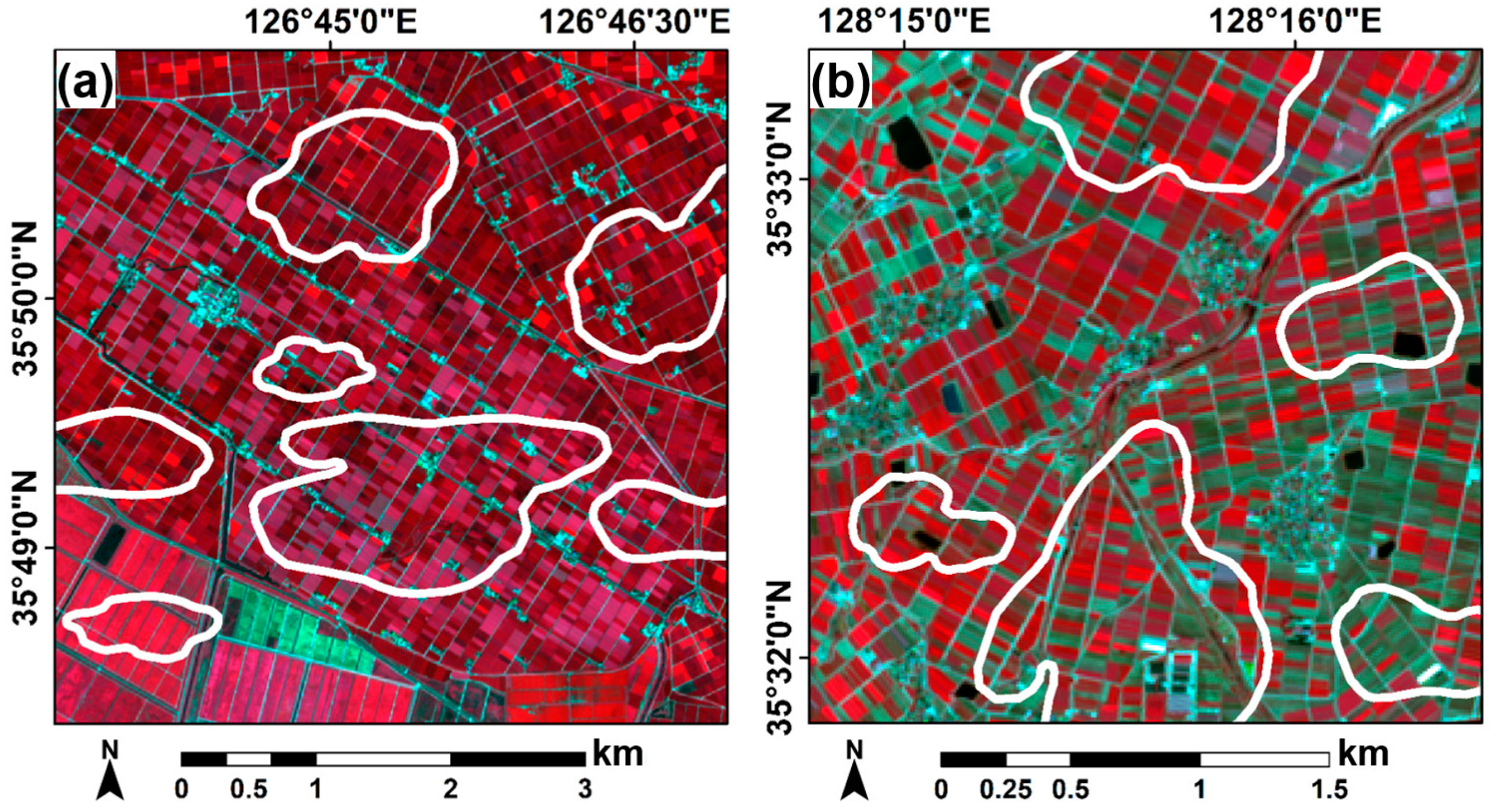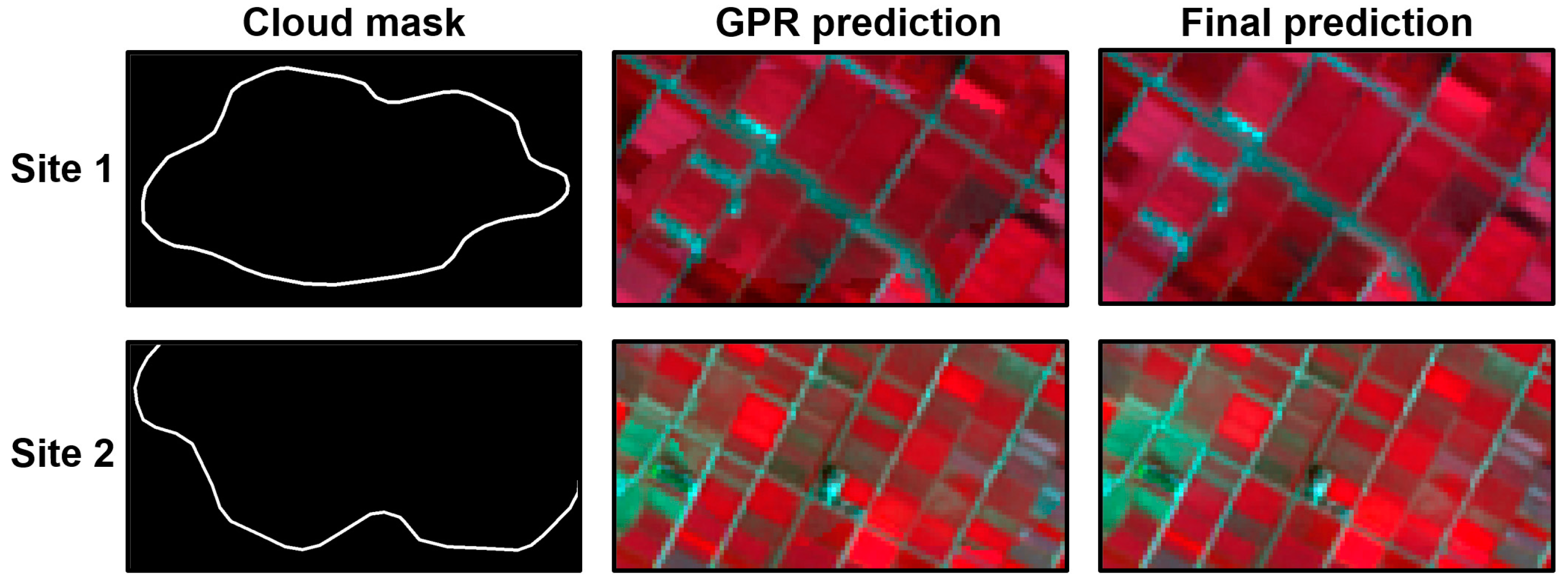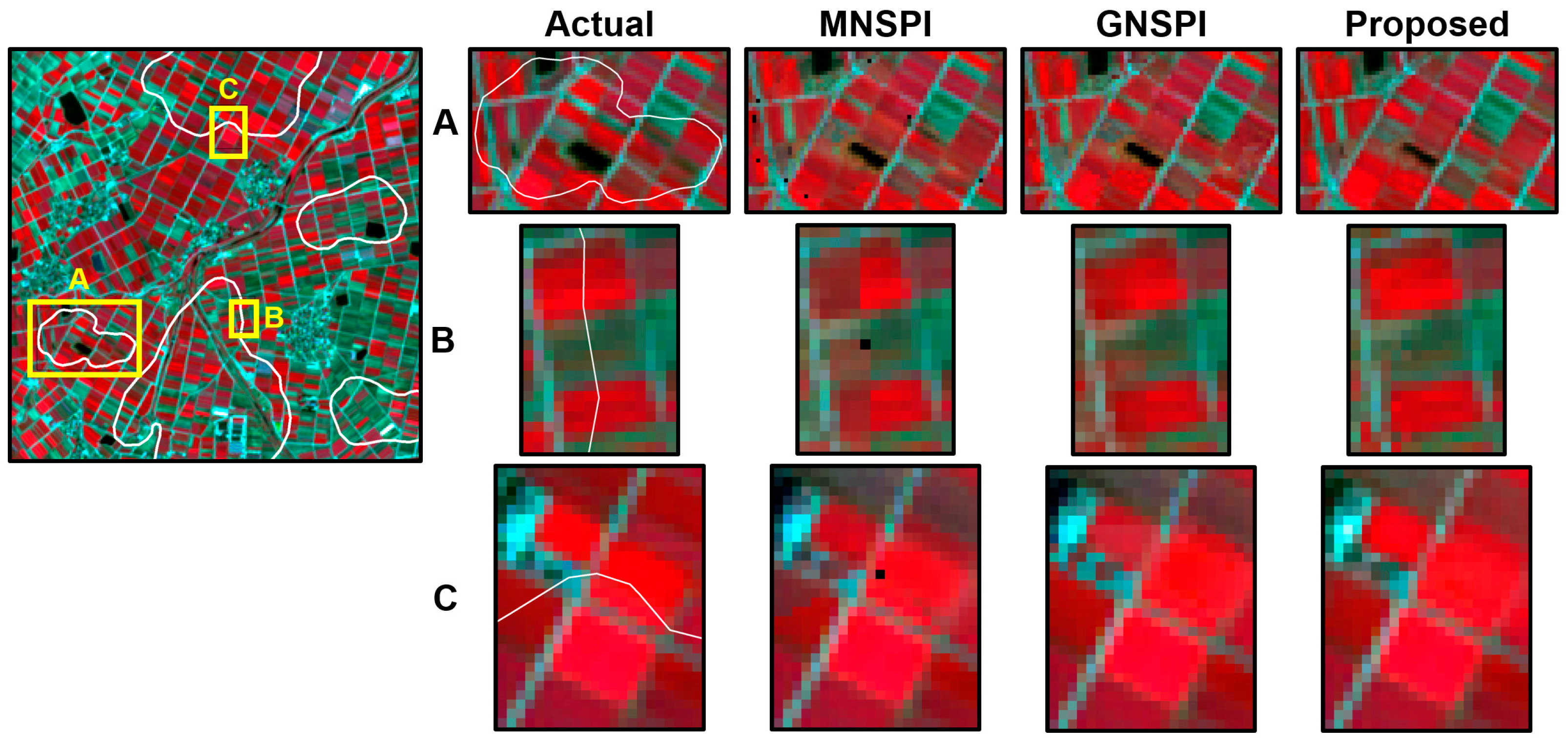Combining Gaussian Process Regression with Poisson Blending for Seamless Cloud Removal from Optical Remote Sensing Imagery for Cropland Monitoring
Abstract
:1. Introduction
2. Methods
2.1. Initial Prediction Using Gaussian Process Regression
- (1)
- The first strategy is inverse uncertainty weighting. Larger weights are assigned predictions with smaller prediction variances, while smaller weights are given to predictions with larger prediction variances.
- (2)
- The second strategy is mean bias correction. When inverse uncertainty weights are normalized, the resulting weighted predictions will likely have much smaller values than the original GPR predictions. Consequently, gradient computation in Poisson blending tends to return smaller gradient values, yielding smoothed blending results. To avoid smoothing effects, the ratio of the mean values from the initial and weighted predictions was empirically considered another weighting factor to preserve the first momentum of the predictions. By considering the empirical mean ratio-based correction term as another weighting factor, the final prediction has the same mean value as the initial predictions but different variations.
2.2. Discontinuity Elimination Using Poisson Blending
3. Experiments
3.1. Study Area and Data
3.2. Experimental Design
4. Results
4.1. Reflectance Prediction
4.2. Vegetation Indices Prediction
5. Discussion
5.1. Contribution of the Study
5.2. Future Research Directions
6. Conclusions
Author Contributions
Funding
Data Availability Statement
Acknowledgments
Conflicts of Interest
References
- Kazemi Garajeh, M.; Salmani, B.; Zare Naghadehi, S.; Valipoori Goodarzi, H.; Khasraei, A. An integrated approach of remote sensing and geospatial analysis for modeling and predicting the impacts of climate change on food security. Sci. Rep. 2023, 13, 1057. [Google Scholar] [CrossRef]
- Karthikeyan, L.; Chawla, I.; Mishra, A.K. A review of remote sensing applications in agriculture for food security: Crop growth and yield, irrigation, and crop losses. J. Hydrol. 2020, 586, 124905. [Google Scholar] [CrossRef]
- Weiss, M.; Jacob, F.; Duveiller, G. Remote sensing for agricultural applications: A meta-review. Remote Sens. Environ. 2020, 236, 111402. [Google Scholar] [CrossRef]
- Boryan, C.; Yang, Z.; Mueller, R.; Craig, M. Monitoring US agriculture: The US department of agriculture, national statistics service, cropland data layer program. Geocarto Int. 2011, 26, 341–358. [Google Scholar] [CrossRef]
- Orynbaikyzy, A.; Gessner, U.; Conrad, C. Crop type classification using a combination of optical and radar remote sensing data: A review. Int. J. Remote Sens. 2019, 40, 6553–6595. [Google Scholar] [CrossRef]
- Muruganantham, P.; Wibowo, S.; Grandhi, S.; Samrat, N.H.; Islam, N. A systematic literature review on crop yield prediction with deep learning and remote sensing. Remote Sens. 2022, 14, 1990. [Google Scholar] [CrossRef]
- Joshi, A.; Pradhan, B.; Gite, S.; Chakraborty, S. Remote-sensing data and deep-learning techniques in crop mapping and yield prediction: A systematic review. Remote Sens. 2023, 15, 2014. [Google Scholar] [CrossRef]
- Na, S.-I.; Hong, S.-Y.; Ahn, H.-Y.; Park, C.-W.; So, K.-H.; Lee, K.-D. Detrending crop yield data for improving MODIS NDVI and meteorological data based rice yield estimation model. Korean J. Remote Sens. 2021, 37, 199–209, (In Korean with English Abstract). [Google Scholar]
- Main-Knorn, M.; Pflug, B.; Louis, J.; Debaecker, V.; Müller-Wilm, U.; Gascon, F. Sen2Cor for Sentinel-2. In Proceedings of the International Society for Optics and Photonics, Warsaw, Poland, 11–14 September 2017; Volume 10427, p. 1042704. [Google Scholar]
- Hagolle, O.; Huc, M.; Desjardins, C.; Auer, S.; Richter, R. MAJA ATBD—Algorithm Theoretical Basis Document; CNES-DLR Report MAJA-TN-WP2-030 V1.0 2017/Dec/07; Zenodo: Meyrin, Switzerland, 2017. [Google Scholar]
- Magno, R.; Rocchi, L.; Dainelli, R.; Matese, A.; Di Gennaro, S.F.; Chen, C.-F.; Son, N.-T.; Toscano, P. AgroShadow: A new Sentinel-2 cloud shadow detection tool for precision agriculture. Remote Sens. 2021, 13, 1219. [Google Scholar] [CrossRef]
- Shen, H.; Li, X.; Cheng, Q.; Zeng, C.; Yang, G.; Li, H.; Zhang, L. Missing information reconstruction of remote sensing data: A technical review. IEEE Geosci. Remote Sens. Mag. 2015, 3, 61–85. [Google Scholar] [CrossRef]
- Wang, Q.; Tang, Y.; Ge, Y.; Xie, H.; Tong, X.; Atkinson, P.M. A comprehensive review of spatial-temporal-spectral information reconstruction techniques. Sci. Remote Sens. 2023, 8, 100102. [Google Scholar] [CrossRef]
- Zhang, Q.; Yuan, Q.; Li, J.; Li, Z.; Shen, H.; Zhang, L. Thick cloud and cloud shadow removal in multitemporal imagery using progressively spatio-temporal patch group deep learning. ISPRS J. Photogramm. Remote Sens. 2020, 162, 148–160. [Google Scholar] [CrossRef]
- Duan, C.; Pan, J.; Li, R. Thick cloud removal of remote sensing images using temporal smoothness and sparsity regularized tensor optimization. Remote Sens. 2020, 12, 3446. [Google Scholar] [CrossRef]
- Darbaghshahi, F.N.; Mohammadi, M.R.; Soryani, M. Cloud removal in remote sensing images using generative adversarial networks and SAR-to-optical image translation. IEEE Trans. Geosci. Remote Sens. 2022, 60, 415309. [Google Scholar] [CrossRef]
- Zhang, C.; Li, W.; Travis, D.J. Restoration of clouded pixels in multispectral remotely sensed imagery with cokriging. Int. J. Remote Sens. 2009, 30, 2173–2195. [Google Scholar] [CrossRef]
- Maalouf, A.; Carré, P.; Augereau, B.; Fernandez-Maloigne, C. A Bandelet-based inpainting technique for clouds removal from remotely sensed images. IEEE Trans. Geosci. Remote Sens. 2009, 47, 2363–2371. [Google Scholar] [CrossRef]
- Criminisi, A.; Pérez, P.; Toyama, K. Region filling and object removal by exemplar-based image inpainting. IEEE Trans. Image Process. 2004, 13, 1200–1212. [Google Scholar] [CrossRef]
- Rakwatin, P.; Takeuchi, W.; Yasuoka, Y. Restoration of Aqua MODIS band 6 using histogram matching and local least squares fitting. IEEE Trans. Geosci. Remote Sens. 2009, 47, 613–627. [Google Scholar] [CrossRef]
- Shen, H.; Zeng, C.; Zhang, L. Recovering reflectance of AQUA MODIS band 6 based on within-class local fitting. IEEE J. Sel. Top. Appl. Earth Obs. Remote Sens. 2011, 4, 185–192. [Google Scholar] [CrossRef]
- Li, X.; Shen, H.; Zhang, L.; Zhang, H.; Yuan, Q. Dead pixel completion of aqua MODIS band 6 using a robust M-estimator multiregression. IEEE Geosci. Remote Sens. Lett. 2014, 11, 768–772. [Google Scholar]
- Helmer, E.H.; Ruefenacht, B. Cloud-free satellite image mosaics with regression trees and histogram matching. Photogramm. Eng. Remote Sens. 2005, 71, 1079–1089. [Google Scholar] [CrossRef]
- Chen, B.; Huang, B.; Chen, L.; Xu, B. Spatially and temporally weighted regression: A novel method to produce continuous cloud-free Landsat imagery. IEEE Trans. Geosci. Remote Sens. 2016, 55, 27–37. [Google Scholar] [CrossRef]
- Li, X.; Shen, H.; Zhang, L.; Zhang, H.; Yuan, Q.; Yang, G. Recovering quantitative remote sensing products contaminated by thick clouds and shadows using multitemporal dictionary learning. IEEE Trans. Geosci. Remote Sens. 2014, 52, 7086–7098. [Google Scholar]
- Tahsin, S.; Medeiros, S.C.; Hooshyar, M.; Singh, A. Optical cloud pixel recovery via machine learning. Remote Sens. 2017, 9, 527. [Google Scholar] [CrossRef]
- Park, S.; Park, N.-W. Cloud removal using Gaussian process regression for optical image reconstruction. Korean J. Remote Sens. 2022, 38, 327–341. [Google Scholar]
- Chen, J.; Zhu, X.; Vogelmann, J.E.; Gao, F.; Jin, S. A simple and effective method for filling gaps in Landsat ETM+ SLC-off images. Remote Sens. Environ. 2011, 115, 1053–1064. [Google Scholar] [CrossRef]
- Zhu, X.; Gao, F.; Liu, D.; Chen, J. A modified neighborhood similar pixel interpolator approach for removing thick clouds in Landsat images. IEEE Geosci. Remote Sens. Lett. 2011, 9, 521–525. [Google Scholar] [CrossRef]
- Lin, C.H.; Tsai, P.H.; Lai, K.H.; Chen, J.Y. Cloud removal from multitemporal satellite images using information cloning. IEEE Trans. Geosci. Remote Sens. 2012, 51, 232–241. [Google Scholar] [CrossRef]
- Hu, C.; Huo, L.Z.; Zhang, Z.; Tang, P. Multi-temporal Landsat data automatic cloud removal using Poisson blending. IEEE Access 2020, 8, 46151–46161. [Google Scholar] [CrossRef]
- Camps-Valls, G.; Verrelst, J.; Munoz-Mari, J.; Laparra, V.; Mateo-Jimenez, F.; Gomez-Dans, J. A survey on Gaussian processes for earth-observation data analysis: A comprehensive investigation. IEEE Geosci. Remote Sens. Mag. 2016, 4, 58–78. [Google Scholar] [CrossRef]
- Verrelst, J.; Alonso, L.; Camps-Valls, G.; Delegido, J.; Moreno, J. Retrieval of vegetation biophysical parameters using Gaussian process techniques. IEEE Trans. Geosci. Remote Sens. 2012, 50, 1832–1843. [Google Scholar] [CrossRef]
- Mateo-Sanchis, A.; Muñoz-Marí, J.; Pérez-Suay, A.; Camps-Valls, G. Warped Gaussian processes in remote sensing parameter estimation and causal inference. IEEE Geosci. Remote Sens. Lett. 2018, 15, 1647–1651. [Google Scholar] [CrossRef]
- Pipia, L.; Muñoz-Marí, J.; Amin, E.; Belda, S.; Camps-Valls, G.; Verrelst, J. Fusing optical and SAR time series for LAI gap filling with multioutput Gaussian processes. Remote Sens. Environ. 2019, 235, 111452. [Google Scholar] [CrossRef] [PubMed]
- Belda, S.; Pipia, L.; Morcillo-Pallarés, P.; Verrelst, J. Optimizing Gaussian process regression for image time series gap-filling and crop monitoring. Agronomy 2020, 10, 618. [Google Scholar] [CrossRef] [PubMed]
- Pipia, L.; Amin, E.; Belda, S.; Salinero-Delgado, M.; Verrelst, J. Green LAI mapping and cloud gap-filling using Gaussian process regression in Google Earth Engine. Remote Sens. 2021, 13, 403. [Google Scholar] [CrossRef] [PubMed]
- Park, S.; Kwak, G.-H.; Ahn, H.-Y.; Park, N.-W. Performance evaluation of machine learning algorithms for cloud removal of optical imagery: A case study in cropland. Korean J. Remote Sens. 2023, 39, 507–519, (In Korean with English Abstract). [Google Scholar]
- Rasmussen, C.E.; Williams, C.K.I. Gaussian Processes for Machine Learning; The MIT Press: Cambridge, MA, USA, 2006. [Google Scholar]
- Liu, M.; Chowdhary, G.; Da Silva, B.C.; Liu, S.Y.; How, J.P. Gaussian processes for learning and control: A tutorial with examples. IEEE Control Syst. Mag. 2018, 38, 53–86. [Google Scholar] [CrossRef]
- Pérez, P.; Gangnet, M.; Blake, A. Poisson image editing. ACM Trans. Graph. 2003, 22, 577–582. [Google Scholar] [CrossRef]
- Matías Di Martino, J.; Facciolo, G.; Meinhardt-Llopis, E. Poisson image editing. Image Process. Line 2016, 6, 300–325. [Google Scholar] [CrossRef]
- ESA. Copernicus Open Access Hub. Available online: https://scihub.copernicus.eu (accessed on 15 August 2023).
- Zhu, X.; Liu, D.; Chen, J. A new geostatistical approach for filling gaps in Landsat ETM+ SLC-off images. Remote Sens. Environ. 2012, 124, 49–60. [Google Scholar] [CrossRef]
- Polyu Remote Sensing Intelligence for Dynamic Earth (Pride). Available online: https://xzhu-lab.github.io/Pride/Open-Source-Code.html (accessed on 4 September 2023).
- Wang, Z.; Bovik, A.C.; Sheikh, H.R.; Simoncelli, E.P. Image quality assessment: From error visibility to structural similarity. IEEE Trans. Image Process. 2004, 13, 600–612. [Google Scholar] [CrossRef] [PubMed]
- Scikit-Learn: GaussianProcessRegressor. Available online: https://scikit-learn.org/stable/modules/generated/sklearn.gaussian_process.GaussianProcessRegressor.html (accessed on 4 September 2023).
- Poisson Image Editing. Available online: https://github.com/willemmanuel/poisson-image-editing (accessed on 4 September 2023).
- Wang, Q.; Wang, L.; Zhu, X.; Ge, Y.; Tong, X.; Atkinson, P.M. Remote sensing image gap filling based on spatial-spectral random forests. Sci. Remote Sens. 2022, 5, 100048. [Google Scholar] [CrossRef]
- Caballero, G.; Pezzola, A.; Winschel, C.; Sanchez Angonova, P.; Casella, A.; Orden, L.; Salinero-Delgado, M.; Reyes-Muñoz, P.; Berger, K.; Delegido, J.; et al. Synergy of Sentinel-1 and Sentinel-2 time series for cloud-free vegetation water content mapping with multi-output Gaussian processes. Remote Sens. 2023, 15, 1822. [Google Scholar] [CrossRef]
- Hoffer, J.G.; Geiger, B.C.; Kern, R. Gaussian process surrogates for modeling uncertainties in a use case of forging superalloys. Appl. Sci. 2022, 12, 1089. [Google Scholar] [CrossRef]
- Goovaerts, P. Geostatistics for Natural Resources Evaluation; Oxford University Press: New York, NY, USA, 1997. [Google Scholar]
- Wang, J.; Lee, C.K.F.; Zhu, X.; Cao, R.; Gu, Y.; Wu, S.; Wu, J. A new object-class based gap-filling method for PlanetScope satellite image time series. Remote Sens. Environ. 2022, 280, 113136. [Google Scholar] [CrossRef]
- Hasan, C.; Horne, R.; Mauw, S.; Mizera, A. Cloud removal from satellite imagery using multispectral edge-filtered conditional generative adversarial networks. Int. J. Remote Sens. 2022, 43, 1881–1893. [Google Scholar] [CrossRef]
- Illarionova, S.; Shadrin, D.; Tregubova, P.; Ignatiev, V.; Efimov, A.; Oseledets, I.; Burnaev, E. A survey of computer vision techniques for forest characterization and carbon monitoring tasks. Remote Sens. 2022, 14, 5861. [Google Scholar] [CrossRef]
- Belgiu, M.; Stein, A. Spatiotemporal image fusion in remote sensing. Remote Sens. 2019, 11, 818. [Google Scholar] [CrossRef]
- Tang, Y.; Wang, Q.; Atkinson, P.M. Filling then spatio-temporal fusion for all-sky MODIS land surface temperature generation. IEEE J. Sel. Top. Appl. Earth Obs. Remote Sens. 2023, 16, 1350–1364. [Google Scholar] [CrossRef]
- Park, S.; Park, N.-W.; Na, S.-I. An object-based weighting approach to spatiotemporal fusion of high spatial resolution satellite images for small-scale cropland monitoring. Agronomy 2022, 12, 2572. [Google Scholar] [CrossRef]






| Specification | Site 1 | Site 2 |
|---|---|---|
| Spectral bands (central wavelength) | Green (560 nm) | |
| Red (665 nm) | ||
| Red-edge (705 nm) | ||
| NIR (842 nm) | ||
| Reference date | 26 July 2021 | 10 March 2021 |
| Prediction date | 20 August 2021 | 14 April 2021 |
| Metric | Band | Site 1 | Site 2 | ||||||
|---|---|---|---|---|---|---|---|---|---|
| MNSPI | GNSPI | GPR | Proposed | MNSPI | GNSPI | GPR | Proposed | ||
| rRMSE | Green | 0.2763 | 0.2627 | 0.2684 | 0.2499 | 0.2171 | 0.2044 | 0.2060 | 0.2004 |
| Red | 0.4449 | 0.4522 | 0.4506 | 0.4368 | 0.3092 | 0.2968 | 0.3013 | 0.2889 | |
| Red-edge | 0.2329 | 0.2181 | 0.2220 | 0.1880 | 0.1600 | 0.1437 | 0.1479 | 0.1421 | |
| NIR | 0.1496 | 0.1333 | 0.1402 | 0.1297 | 0.2240 | 0.2060 | 0.2044 | 0.1959 | |
| SSIM | Green | 0.7119 | 0.7184 | 0.7073 | 0.7600 | 0.8530 | 0.8704 | 0.8606 | 0.8678 |
| Red | 0.7993 | 0.7746 | 0.7839 | 0.8014 | 0.8286 | 0.8444 | 0.8372 | 0.8512 | |
| Red-edge | 0.4771 | 0.5073 | 0.4790 | 0.6784 | 0.7798 | 0.8212 | 0.8066 | 0.8225 | |
| NIR | 0.6428 | 0.7104 | 0.6688 | 0.7326 | 0.6435 | 0.7038 | 0.7103 | 0.7439 | |
| Metric | VI | Site 1 | Site 2 | ||||||
|---|---|---|---|---|---|---|---|---|---|
| MNSPI | GNSPI | GPR | Proposed | MNSPI | GNSPI | GPR | Proposed | ||
| rRMSE | NDVI | 0.0982 | 0.1004 | 0.0984 | 0.0948 | 0.2614 | 0.2543 | 0.2563 | 0.2445 |
| NDRE | 0.1329 | 0.1303 | 0.1320 | 0.1153 | 0.2955 | 0.2852 | 0.2764 | 0.2639 | |
| NDWI | 0.1037 | 0.1025 | 0.0995 | 0.0937 | 0.2110 | 0.2043 | 0.1969 | 0.1884 | |
| SSIM | NDVI | 0.7949 | 0.7674 | 0.8023 | 0.8129 | 0.7573 | 0.7799 | 0.7881 | 0.8128 |
| NDRE | 0.6949 | 0.6842 | 0.7011 | 0.7433 | 0.7168 | 0.7494 | 0.7781 | 0.8077 | |
| NDWI | 0.7452 | 0.7266 | 0.7719 | 0.8002 | 0.7350 | 0.7632 | 0.7918 | 0.8138 | |
Disclaimer/Publisher’s Note: The statements, opinions and data contained in all publications are solely those of the individual author(s) and contributor(s) and not of MDPI and/or the editor(s). MDPI and/or the editor(s) disclaim responsibility for any injury to people or property resulting from any ideas, methods, instructions or products referred to in the content. |
© 2023 by the authors. Licensee MDPI, Basel, Switzerland. This article is an open access article distributed under the terms and conditions of the Creative Commons Attribution (CC BY) license (https://creativecommons.org/licenses/by/4.0/).
Share and Cite
Park, S.; Park, N.-W. Combining Gaussian Process Regression with Poisson Blending for Seamless Cloud Removal from Optical Remote Sensing Imagery for Cropland Monitoring. Agronomy 2023, 13, 2789. https://doi.org/10.3390/agronomy13112789
Park S, Park N-W. Combining Gaussian Process Regression with Poisson Blending for Seamless Cloud Removal from Optical Remote Sensing Imagery for Cropland Monitoring. Agronomy. 2023; 13(11):2789. https://doi.org/10.3390/agronomy13112789
Chicago/Turabian StylePark, Soyeon, and No-Wook Park. 2023. "Combining Gaussian Process Regression with Poisson Blending for Seamless Cloud Removal from Optical Remote Sensing Imagery for Cropland Monitoring" Agronomy 13, no. 11: 2789. https://doi.org/10.3390/agronomy13112789
APA StylePark, S., & Park, N.-W. (2023). Combining Gaussian Process Regression with Poisson Blending for Seamless Cloud Removal from Optical Remote Sensing Imagery for Cropland Monitoring. Agronomy, 13(11), 2789. https://doi.org/10.3390/agronomy13112789








